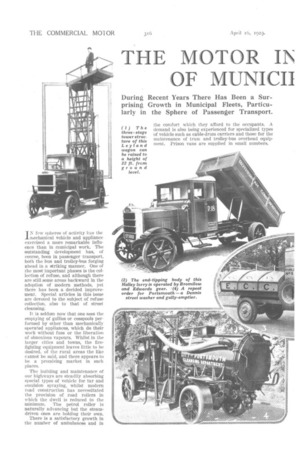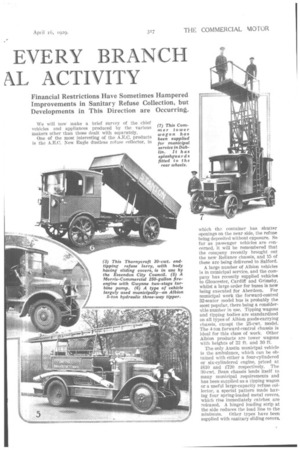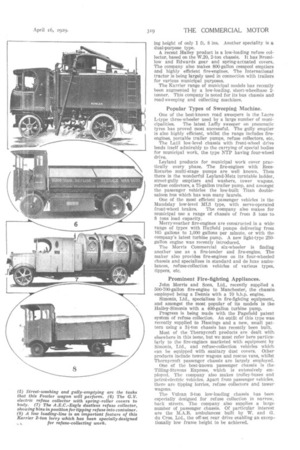THE MOT01": TN
Page 110

Page 111

Page 112

Page 113

If you've noticed an error in this article please click here to report it so we can fix it.
EVERY RAN CH F MUNICH AL ACTIVI TY
INfew spheres of activity has the mechanical vehicle and appliance exercised a more remarkable influence than in municipal work. The outstanding development has, of course, been in passenger transport, both the bus and trolley-bus forging ahead in a striking manner. One of the most important phases is the collection of refuse, and although there are still some areas backward in the adoption of modern methods, yet there has been a decided improvement. Special articles in this issue are devoted to the subject of refuse collection, also to that of street cleansing.
It is seldom now that one sees the emptying of gullies or cesspools performed by other than mechanically operated appliances, which do their work without fuss or •the liberation of obnoxious vapours. Whilst in the larger cities and towns, the firefighting equipment leaves little to be desired, of the rural areas the like cannot be said, and there appears to be a promising market in such places.
The building and maintenance of our highways are steadily absorbing special types of vehicle for tar and emulsion spraying, whilst modern road construction has necessitated the provision of road rollers ill which the dwell is reduced to the minimum. The petrol roller is naturally advancing but the steamdriven ones are holding their own.
There is a satisfactory growth in the number of ambulances and in the comfort which they afford to the occupants. A demand is also being experienced for specialized types of vehicle such as cable-drum carriers and those for the maintenance of tram and trolley-bus overhead equipment. Prison vans are supplied in small numbers. We will now make a brief survey of the chief vehicles and appliances produced by the various makers other than those dealt with separately.
One of the most interesting of the A.E.C. products is the A.E.C. New Eagle dustless refuse collector, in which the container has shutter openings on the near side, the refuse being deposited without exposure. So far as passenger vehicles are concerned, it will be remembered that the company recently brought out the new Reliance chassis, and 15 of these are being delivered to Salford.
A large number of Albion vehicles is in municipal service, and the company has recently supplied vehicles • to Gloucester, Cardiff and Grimsby, whilst a large order for buses is now being executed for Aberdeen. For municipal work the forward-control 32-seater model bus is probably the most popular, there being a considerable number in use. Tipping wagons and tipping bodies are standardized on all types of Albion goods-carrying chassis, except the 25-cwt. model. The 4-ton forward-control chassis is ideal for this class of work. Other Albion products are tower wagons with heights of 22 ft. and 30 ft.
The only Austin municipal vehicle is the ambulance, which can be obtained with either a four-cylindered or six-cylindered engine, priced at 1610 and £720 respectively. The 30-cwt. Bean chassis lends itself to many municipal requirements and has been supplied as a tipping wagon or a useful large-capacity refuse collector, a special pattern made having four spring-loaded metal covers, which rise immediately catches are released. A hinged loading strip at the side reduces the load line to the minimum. Other types have been supplied with sanitary sliding covers. A large number of municipal vehicles has been supplied by Cotnmer Cars, Ltd., these including gully and cesspool emptiers of 600-gallon to 1,200-gallon capacities, either as separate machines or models combining the two functions; house-refuse collectors from 30 cwt. to 5 tons, with canvas or metal covers and tipping gear ; gravity or pressure-fed street sprinklers; and combined sprinklers and washers, ranging from 350-gallon to 1,200-gallon capacity, whilst the 30-cwt. and modified 5P chassis are available for ambulance work.
Many useful trailers are built by Carrimore Six Wheelers, Ltd. For instance, there is one with tarspraying equipment, also hydraulically operated tippers for refuse collection, dual-purpose refuse collectors and granite carriers, and low-loading collectors. Special low-level trailers have been built for cable-drum and pipe carrying.
Chenard-Walcker Tractors (England) market a particularly efficient tractor for hauling any ordinary type of trailer. It is capable of high speeds and will handle loads up to 15 tons.
Some Important Passenger Models.
The Crossley Eagle 30-70 h.p. passenger chassis is a popular model with municipal authorities. The maker also builds six-wheelers and a well-equipped six-cylinder motor ambulance. The sole commercialvehicle product of the Daimler Co.; Ltd., is the new CFO coach and bus chassis. This is a particularly fine model which is likely to have an excellent future.
Dennis products have long been famous in municipal work and form a comprehensive range. Many of them are dealt with elsewhere, but we will refer particularly to the low-level buses with servo-operated brakes, ranging in capacity from 20-seaters to 54-seaters, the fire-engines in which an especially compact and efficient pump is employed, and the G-type ambulance chassis. We must not forget the Dennis refuse collector with a loading height of 4 ft. 4 ins., the weight being under 2 tons.
Most of the Dodge Brothers' vehicles in municipal service are employed either as ambulances or for road-building purposes.
Trailers by R. A. Dyson and Co., Ltd., are used for many purposes. One of the largest is a 15-ton model for cable drums, transformers and other heavy machinery. A popular model for loose material is that fitted with two steel hoppers, whilst the 5-ton end-tipper is much used for general utility purposes and a number of low-loading refuse collectors has been supplied. The Eagle Engineering Co., Ltd., specializes in equipment for the hygienic collection of house refuse, and outfits have recently been supplied to the city of Westminster, also to Sheffield.
Various Types of Refuse Collector.
Electricars, Ltd., markets a low-loading, batteryelectric vehicle which can be equipped with sanitary, sliding or canvas covers. Birmingham uses a model with metal flaps. A large number of battery-electric vehicles is being built by Electromobile, Ltd.
Neat, low chassis for carrying refuse-collecting and other types of body is marketed by Easyloaders, Ltd. A speciality of the Four Wheel Drive Lorry Co., Ltd., is an effective and large-capacity outfit for spraying roads with bituminous emulsion.
A useful Garner dual-purpose vehicle combines the work of refuse-collecting or tipping with road-watering. The General Vehicle Co., Ltd., markets a 2-ton electric low-level refuse vehicle, •which is giving great satisfaction. Vehicles of this make are also being used for a wide variety of other purposes. Two Garrett sndertype six-wheelers, with Bromilow and Edwards three-way tipping gear, have recently been delivered to Gloucester for carrying road material.
Perhaps the most striking of the Guy products are the six-wheeled double-saloon bus and the trolley-bus, these having been supplied in large numbers. The company also makes gully emptiers, street sprayers and refuse-collecting vehicles, the last-named having a load
ing height of only 1 ft. 8 ins. Another speciality is a dual-purpose type.
A. recent Halley product is a low-loading refuse collector, based on the W.20, 2-ton chassis. It has Broadlow and Edwards gear and spring-actuated covers. The company also makes 800-gallon cesspool emptiers and highly efficient fire-engines. The International tractor is being largely used in connection with trailers for various municipal purposes.
The Karrier range of municipal models has recently been augmented by a low-loading, short-wheelbase 2tonner. This company is noted for its bus chassis and road-sweeping and collecting machines.
Popular Types of Sweeping Machine.
One of the best-known road sweepers is the.Lacre L-type three-wheeler used by a large number of muni cipalities. The latest Lail:1y sweeper on pneumatic tyres has proved most successful. The gully emptier is also highly efficient, whilst the range includes fireengines, portable trailer pumps, refuse collectors, etc.
The Latil low-level chassis with front-wheel drive lends itself admirably to the carrying of special bodies for municipal work, the type NTP having four-wheel drive.
Leyland products for municipal work cover practically every phase. The fire-engines with ReesRoturbo multi-stage pumps are well known. Then there is the wonderful Leyland-Metz turntable ladder, street-gully emptiers and washers, tower wagons, refuse collectors, a 75-gallon trailer pump, and amongst the passenger vehicles the low-built Titan doublesaloon bus which has won many laurels.
One of the most efficient passenger vehicles is the Maudslay ML3 type, with servo-operated front-wheel brakes. The company also makes for municipal use a range of chassis of from 3 tons to 8 tons load capacity.
Merryweather fire-engines are constructed in a wide range of types with Hatfield pumps delivering from -165 gallons to 1,000 gallons per minute, or with the company's latest turbine pump. A new light-type 250gallon engine was recently introduced.
The Morris Commercial six-wheeler is finding another use as a fire-tender and fire-engine. The maker also provides fire-engines on its four-wheeled chassis and specializes in standard and de luxe ambulances, refuse-collection vehicles of various types, tippers, etc.
Prominent Fire-fighting Appliances.
John Morris and Sons, Ltd., recently supplied a 500-700-gallon fire-engine to Manchester, the chassi& employed being a Dennis with a 70 b.b.p. engine.
Simonis, Ltd., specializes in fire-fighting equipment, and amongst the most popular of its models is the
with a 400-gallon turbine pump.
Progress is being made with the Pagefield patent system of refuse collection. An outfit of this type was recently supplied to Hastings and a new, small pattern using a 33.-ton chassis has recently been built.
Most of the Thornycroft products are dealt with elsewhere in this issue, but we must refer here particularly to the fire-engines marketed with equipment by Simonis, Ltd., and refuse-collection vehicles which, can be equipped with sanitary dust covers. Other. products include tower wagons and rescue vans, whilst Thornycroft passenger chassis are largely employed.
One of the best-known passenger chassis is the Tilling-Stevens Express, which is extensively employed. The company also makes trolley-buses and petrol-electric vehicles. Apart from passenger vehicles, there are tipping lorries, refuse collectors and towerwagons.
The Vulcan 3-ton low-loading chassis bas been especially designed for refuse collection in narrow, back streets. The company also supplies a large. number of passenger chassis. Of particular interest are the M.A.B. ambulances built by W. and G, du Coos, Ltd., the off-set rear drive enabling an exceptionally low frame height to be achieved.








































































































































































































